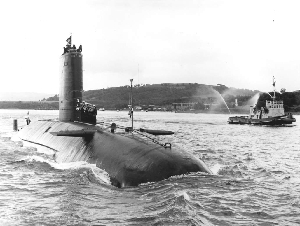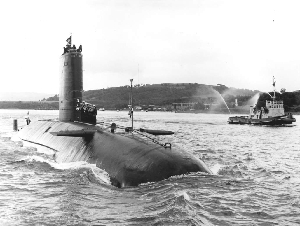File:HMS Conqueror (S48).jpg - Wikipedia
 Article Images
Article Images
| Description |
HMS Conqueror (S48) 4 July 1982 returning to the Clyde Submarine base (Faslane) from the Falklands War. The Jolly Roger on the tower carries an atomic symbol (as it is the first to be flown by a nuclear submarine) as well as a symbol denoting a sunken warship and a dagger for a special ops raid. The British Naval tradition is to fly a Jolly Roger when returning to port when the sub made a kill at sea. The symbolism used was not standard, normally a red bar indicated a warship sunk, Conqueror used a silhouette of a warship in white bunting. Crossed torpedoes were used instead of cross bones under the skull. The dagger for a special operation was not strictly correct as the landing of special forces was done into Grytviken after the fall of S Georgia rather than as part of its recapture. |
|---|---|
| Source |
Courtesy of Navyphotos: Image on website |
| Article | |
| Portion used |
Entire photo |
| Low resolution? |
Yes |
| Purpose of use |
In HMS Conqueror (S48), to identify and illustrate HMS Conqueror. |
| Replaceable? |
No; HMS Conqueror was decommissioned along with the other Churchill class submarines in the early 1990s. |
| Fair useFair use of copyrighted material in the context of HMS Conqueror (S48)//en.wikipedia.org/wiki/File:HMS_Conqueror_(S48).jpgtrue | |
| Description |
HMS Conqueror (S48) 4 July 1982 returning to the Clyde Submarine base (Faslane)from the Falklands War. The Jolly Roger on the tower carries an atomic symbol (as it is the first to be flown by a nuclear submarine) as well as a symbol denoting a sunken warship and a dagger for a special ops raid. The British Naval tradition is to fly a Jolly Roger when returning to port when the sub made a kill at sea. The symbology used was not standard, normally a red bar indicated a warship sunk, Conqueror used a silhouette of a warship in white bunting. Crossed torpedoes were used instead of cross bones under the skull. The dagger for a special operation was not strictly correct as the landing of special forces was done into Grytviken after the fall of S Georgia rather than as part of its recapture. |
|---|---|
| Source |
Courtesy of Navyphotos |
| Article | |
| Portion used |
Entire photo |
| Low resolution? |
Yes |
| Purpose of use |
In Churchill-class submarine, to identify and illustrate Churchill class submarines and specifically the most famous member of that class, on her return to port signalling the kill that made her famous. |
| Replaceable? |
No; HMS Conqueror was decommissioned along with the other Churchill class submarines in the early 1990s. |
| Fair useFair use of copyrighted material in the context of Churchill-class submarine//en.wikipedia.org/wiki/File:HMS_Conqueror_(S48).jpgtrue | |
| Description |
HMS Conqueror (S48) 4 July 1982 returning to the Clyde Submarine base (Faslane)from the Falklands War. The Jolly Roger on the tower carries an atomic symbol (as it is the first to be flown by a nuclear submarine) as well as a symbol denoting a sunken warship and a dagger for a special ops raid. The British Naval tradition is to fly a Jolly Roger when returning to port when the sub made a kill at sea. The symbology used was not standard, normally a red bar indicated a warship sunk, Conqueror used a silhouette of a warship in white bunting. Crossed torpedoes were used instead of cross bones under the skull. The dagger for a special operation was not strictly correct as the landing of special forces was done into Grytviken after the fall of S Georgia rather than as part of its recapture. |
|---|---|
| Source |
Courtesy of Navyphotos |
| Article | |
| Portion used |
Entire photo |
| Low resolution? |
Yes |
| Purpose of use |
In British naval forces in the Falklands War, as to depict a very significant member of these forces, as the only nuclear-powered submarine ever to sink a ship, signalling that event. |
| Replaceable? |
No; depicts a unique historic event. |
| Fair useFair use of copyrighted material in the context of British naval forces in the Falklands War//en.wikipedia.org/wiki/File:HMS_Conqueror_(S48).jpgtrue | |
 | This image is a faithful digitisation of a unique historic image, and the copyright for it is most likely held by the person who created the image or the agency employing the person. It is believed that the use of this image may qualify as non-free use under the Copyright law of the United States. Any other uses of this image, on Wikipedia or elsewhere, may be copyright infringement. See Wikipedia:Non-free content for more information.
Please remember that the non-free content criteria require that non-free images on Wikipedia must not "[be] used in a manner that is likely to replace the original market role of the original copyrighted media." Use of historic images from press agencies must only be of a transformative nature, when the image itself is the subject of commentary rather than the event it depicts (which is the original market role, and is not allowed per policy). |
| If this tag does not accurately describe this image, please replace it with an appropriate one. | |
File history
Click on a date/time to view the file as it appeared at that time.
| Date/Time | Thumbnail | Dimensions | User | Comment | |
|---|---|---|---|---|---|
| current | 22:37, 9 June 2007 |  | 300 × 226 (42 KB) | Remember the dot (talk | contribs) | cropped and scaled down |
You cannot overwrite this file.
File usage
The following 3 pages use this file:
This file contains additional information, probably added from the digital camera or scanner used to create or digitize it.
If the file has been modified from its original state, some details may not fully reflect the modified file.
| _error | 0 |
|---|
